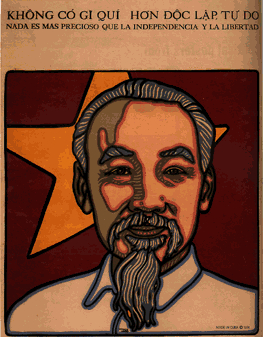|
Chapter summaries
|
Online Chapter: Peace Symbols: Posters in Movements against the Wars in Vietnam and IraqPart 1. The Movement(s) against the War in VietnamU.S. involvement in the conflict in Vietnam can be traced back to the 1950s when France was the major protagonist in a war against nationalist forces seeking to overthrow French colonial control of the country then known as Indochina. The French efforts were essentially defeated by the late 1950s, and gradually the U.S. presence expanded, moving from CIA agents as “military advisers” to full-fledged combat units. As the U.S. government became more involved, the conflict was portrayed as a major front in a worldwide effort against communism. In contrast, most people inside Vietnam, and many outside, saw the conflict as an anticolonial independence movement that had been turned into a civil war by French and U.S. efforts to back figures they thought more pliable than the main Vietnamese leader, Ho Chi Minh (Figure 14).
Figure 14. Rene Medero, 1974. Courtesy of Sixties Project. Ho Chi Minh: “Nothing is more precious than independence and liberty.” Ho had originally asked for U.S. aid in his independence movement, suggesting that a country founded on an anticolonial Declaration of Independence should be sympathetic to his efforts. But amidst a simplistic Cold War division of the world into good guys and bad guys, the United States decided Ho was a bit too independent to be a good guy. This, and a more sympathetic reception from the Soviet Union, led to the self-fulfilling prophecy of Ho’s alignment with (his own Vietnamese form of) communism, although in his own Vietnamese form. The 1960s was as culturally and politically exciting and dynamic as any decade in U.S. history, and the war in Vietnam was at the center of much of the era’s activity. In the early sixties, under President Kennedy, political leaders had begun to debate the U.S. “police action” in Vietnam, but it did not widely register on the American political scene for several more years. By 1964, both the war and an antiwar movement were slowly emerging into public consciousness. As has been the case in much of U.S. history, the peace churches, especially the Society of Friends, were among the first to express opposition to the war. Over the course of the next ten years, the peace movement expanded continuously, to include major youth contingents, some prominent liberal politicians, and eventually a majority of all Americans, as well as most of the rest of the world. Key developments in the United States included the emergence of a vast “New Left” student movement and a youth counterculture known popularly as hippies. These new contingents built on and were to a degree stabilized by long-term activists from the pacifist churches and veterans of the antinuclear efforts of the 1950s. Indeed, the most famous emblem of the Vietnam War era, the peace symbol, originated as athe “Ban the Bomb” logo of Britain’s Campaign for Nuclear Disarmament (CND) in 1958 (Figure 15).3
Figure 15. CND archive. 3. On the history of the peace symbol. |
|||


